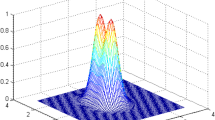Abstract
This is an overview over standard techniques for holonomic functions, written for readers who are new to the subject. We state the definition for holonomy in a couple of different ways, including some concrete special cases as well as a more abstract and more general version. We give a collection of standard examples and state several fundamental properties of holonomic objects. Two techniques which are most useful in applications are explained in some more detail: closure properties, which can be used to prove identities among holonomic functions, and guessing, which can be used to generate plausible conjectures for equations satisfied by a given function.
Access this chapter
Tax calculation will be finalised at checkout
Purchases are for personal use only
Similar content being viewed by others
References
Abramowitz, M., Stegun, I.A.: Handbook of Mathematical Functions, 9th edn. Dover Publications, Inc., New York (1972)
Andrews, G.E., Askey, R., Roy, R.: Special Functions. Encyclopedia of Mathematics and Its Applications, vol. 71. Cambridge University Press, Cambridge/New York (1999)
Beckermann, B., Labahn, G.: Fraction-free computation of matrix rational interpolants and matrix gcds. SIAM J. Matrix Anal. Appl. 22(1), 114–144 (2000)
Bernstein, J.N.: The analytic continuation of generalized functions with respect to a parameter. Funct. Anal. Appl. 6(4), 26–40 (russian); 273–285 (english translation) (1972)
Bjork, J.E.: Rings of Differential Operators. North-Holland, Amsterdam/New York (1979)
Blümlein, J., Kauers, M., Klein, S., Schneider, C.: Determining the closed forms of the \(o(a_{s}^{3})\) anomalous dimension and Wilson coefficients from Mellin moments by means of computer algebra. Comput. Phys. Commun. 180(11), 2143–2165 (2009)
Blümlein, J., Klein, S., Schneider, C., Stan, F.: A symbolic summation approach to Feynman integral calculus. J. Symb. Comput. 47(10), 1267–1289 (2012)
Bostan, A., Kauers, M.: Automatic classification of restricted lattice walks. In: Proceedings of FPSAC’09, Hagenberg, pp. 201–215 (2009)
Bostan, A., Kauers, M., with an appendix by van Hoeij, M.: The complete generating function for Gessel walks is algebraic. Proc. AMS 138(9), 3063–3078 (2010)
Bronstein, M., Petkovšek, M.: An introduction to pseudo-linear algebra. Theor. Comput. Sci. 157(1), 3–33 (1996)
Chen, S., Kauers, M.: Order-degree curves for hypergeometric creative telescoping. In: Proceedings of ISSAC’12, Grenoble, pp. 122–129. ACM (2012). ISBN 978-1-4503-1269-1
Chen, S., Kauers, M.: Trading order for degree in creative telescoping. J. Symb. Comput. 47(8), 968–995 (2012)
Chudnovsky, D.V., Chudnovsky, G.V.: Computer algebra in the service of mathematical physics and number theory. In: Chudnovsky, D.V., Jenks, R.D. (eds.) Computers in Mathematics. Lecture Notes in Pure and Applied Mathematics, vol. 125, pp. 109–232. Dekker/Stanford University (1986). ISBN 0-8247-8341-7
Chyzak, F.: An extension of Zeilberger’s fast algorithm to general holonomic functions. Discret. Math. 217, 115–134 (2000)
Chyzak, F., Salvy, B.: Non-commutative elimination in Ore algebras proves multivariate identities. J. Symb. Comput. 26, 187–227 (1998)
Chyzak, F., Kauers, M., Salvy, B.: A non-holonomic systems approach to special function identities. In: May, J. (ed.) Proceedings of ISSAC’09, Seoul, pp. 111–118. ACM (2009). ISBN 978-1-4503-1269-1
Corless, R.M., Gonnet, G.H., Hare, D.E., Jeffrey, D.J., Knuth, D.E.: On the Lambert W function. Adv. Comput. Math. 5, 329–359 (1996)
Flajolet, P., Sedgewick, R.: Analytic Combinatorics. Cambridge University Press, Cambridge/New York (2009)
Gerhold, S.: Combinatorial sequences: non-holonomicity and inequalities. Ph.D. thesis, RISC-Linz, Johannes Kepler Universität Linz (2005)
Hebisch, W., Rubey, M.: Extended Rate, more GFUN. J. Symb. Comput. 46(8), 889–903 (2011)
Jaroschek, M., Kauers, M., Chen, S., Singer, M.F.: Desingularization explains order-degree curves for Ore operators. Technical report 1301.0917, ArXiv (2013)
Kauers, M.: Fast solvers for dense linear systems. Nucl. Phys. B (Proc. Suppl.) 183, 245–250 (2008)
Kauers, M.: Guessing handbook. Technical report 09–07, RISC-Linz (2009)
Kauers, M.: A mathematica package for computing asymptotic expansions of solutions of p-finite recurrence equations. Technical report 11–04, RISC-Linz (2011)
Kauers, M., Paule, P.: The Concrete Tetrahedron. Springer, Wein/New York (2011)
Kauers, M., Zeilberger, D.: The computational challenge of enumerating high dimensional rook walks. Adv. Appl. Math. 47(4), 813–819 (2011)
Koutschan, C.: Advanced applications of the holonomic systems approach. Ph.D. thesis, RISC-Linz, Johannes Kepler Universität Linz (2009)
Koutschan, C.: HolonomicFunctions (User’s Guide). Technical report 10–01, RISC report series, University of Linz, Austria (2010). URL http://www.risc.uni-linz.ac.at/research/combinat/software/HolonomicFunctions/
Mallinger, C.: Algorithmic manipulations and transformations of univariate holonomic functions and sequences. Master’s thesis, Johannes Kepler University, Linz (1996)
Mezzarobba, M., Salvy, B.: Effective bounds for P-recursive sequences. J. Symb. Comput. 45(10), 1075–1096 (2010)
Salvy, B.: D-finiteness: algorithms and applications. In: Kauers, M. (ed.) Proceedings of ISSAC’05, Beijing, pp. 2–3. ACM (2005). ISBN 978-1-4503-1269-1. Invited talk
Salvy, B., Zimmermann, P.: Gfun: a Maple package for the manipulation of generating and holonomic functions in one variable. ACM Trans. Math. Softw. 20(2), 163–177 (1994)
Sloane, N.J.: The on-line encyclopedia of integer sequences. http://www.oeis.org/
Stanley, R.P.: Differentiably finite power series. Eur. J. Comb. 1, 175–188 (1980)
Stanley, R.P.: Enumerative Combinatorics, Volume 2. Cambridge Studies in Advanced Mathematics, vol. 62. Cambridge University Press, Cambridge (1999)
van der Hoeven, J.: Fast evaluation of holonomic functions. Theor. Comput. Sci. 210(1), 199–216 (1999)
van der Hoeven, J.: Efficient accelero-summation of holonomic functions. J. Symb. Comput. 42(4), 389–428 (2007)
van der Poorten, A.: A proof that Euler missed… – Apéry’s proof of the irrationality for ζ(3). Math. Intell. 1, 195–203 (1979)
von zur Gathen, J., Gerhard, J.: Modern Computer Algebra. Cambridge University Press, Cambridge/New York (1999)
Wilf, H.S., Zeilberger, D.: An algorithmic proof theory for hypergeometric (ordinary and q) multisum/integral identities. Invent. Math. 108, 575–633 (1992)
Wimp, J., Zeilberger, D.: Resurrecting the asymptotics of linear recurrences. J. Math. Anal. Appl. 111, 162–176 (1985)
Zeilberger, D.: A holonomic systems approach to special function identities. J. Comput. Appl. Math. 32, 321–368 (1990)
Author information
Authors and Affiliations
Corresponding author
Editor information
Editors and Affiliations
Rights and permissions
Copyright information
© 2013 Springer-Verlag Wien
About this chapter
Cite this chapter
Kauers, M. (2013). The Holonomic Toolkit. In: Schneider, C., Blümlein, J. (eds) Computer Algebra in Quantum Field Theory. Texts & Monographs in Symbolic Computation. Springer, Vienna. https://doi.org/10.1007/978-3-7091-1616-6_5
Download citation
DOI: https://doi.org/10.1007/978-3-7091-1616-6_5
Published:
Publisher Name: Springer, Vienna
Print ISBN: 978-3-7091-1615-9
Online ISBN: 978-3-7091-1616-6
eBook Packages: Computer ScienceComputer Science (R0)




